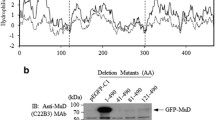Abstract
APO2 ligand (APO2L)/TRAIL is a novel member of the tumor necrosis factor cytokine family and a potent inducer of apoptosis in tumor cell lines. We recently reported that APO2L is consistently expressed in low-grade astrocytomas, anaplastic astrocytomas, glioblastomas, and cell lines derived thereof, and that malignant glioma cell lines are susceptible to APO2L-induced apoptosis. In this study, we investigated whether APO2L is expressed in medulloblastoma or neuroblastoma cell lines and whether these cells are sensitive to APO2L-induced apoptosis. Immunoblot analyses revealed full-length APO2L protein expression in one (DAOY) of three medulloblastoma cell lines but not in two neuroblastoma cell lines (SKN-BE and SKN-LE). Viability assay performed after exposure to soluble APO2L for 16 h showed that DAOY medulloblastoma cells were the most sensitive and that apoptosis induced by APO2L was greatly enhanced when protein synthesis was inhibited by cycloheximide. Neuroblastoma cell lines were almost completely resistant to APO2L-induced apoptosis. We also carried out APO2L immunohistochemistry in a total of 115 tumors of the nervous system with different histogenesis and biological behavior. In all 9 pilocytic astrocytomas, the areas of dense fibrillary network showed diffuse and strong APO2L expression. In oligodendrogliomas, APO2L expression was observed in areas with a significant admixture of astrocytic cells, but was absent in neoplastic oligodendrocytes. In 13 of 14 ependymomas, APO2L was expressed in perivascular pseudorosettes. In all 12 medulloblastomas, strong APO2L expression was observed in intra-tumoral-reactive astrocytes, but neoplastic cells did not show APO2L immunoreactivity. Thus, the pattern of APO2L expression was largely similar to that of glial fibrillary acidic protein (GFAP), except for choroid plexus tumors and 3 of 8 anaplastic meningiomas, in which APO2L was focally expressed without concomitant GFAP expression. APO2L expression was absent in meningiomas, neurocytomas, and schwannomas. Thus, there is considerable heterogeneity of APO2L expression and susceptibility to APO2L-induced apoptosis among human brain tumors.
Similar content being viewed by others
Author information
Authors and Affiliations
Additional information
Received: 18 August 1999 / Revised, accepted: 29 September 1999
Rights and permissions
About this article
Cite this article
Nakamura, M., Rieger, J., Weller, M. et al. APO2L/TRAIL expression in human brain tumors. Acta Neuropathol 99, 1–6 (2000). https://doi.org/10.1007/PL00007399
Issue Date:
DOI: https://doi.org/10.1007/PL00007399




